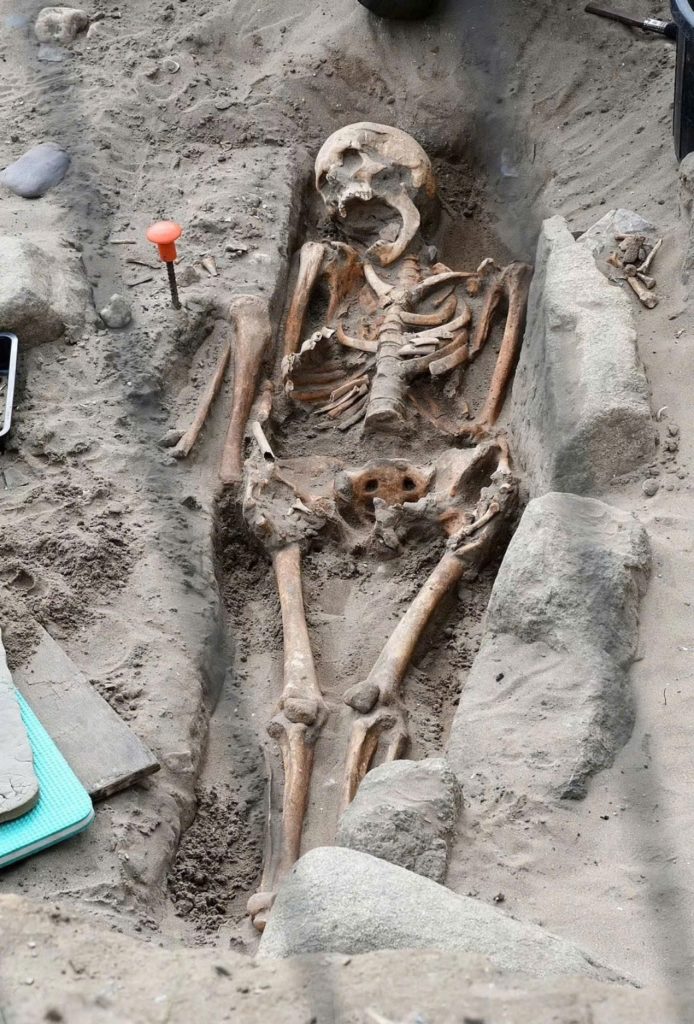In an extraordinary archaeological breakthrough, researchers have uncovered approximately 200 medieval skeletons in Whitesands Bay near St. David’s, Wales. This discovery offers a rare and profound insight into an early Christian community, shedding light on burial practices and daily life that date back to the sixth century.

Lying just beneath the surface of what is now a bustling beach destination, archaeologists have stumbled upon a burial site containing the remarkably preserved remains of men, women, and children. The preservation of these skeletons has been described as “absolutely incredible,” a phenomenon attributed to their complete submersion in sand, which protected the bones from the usual ravages of time. This rare state of preservation is a treasure trove for researchers eager to uncover details about a community that lived over a millennium ago.
Clues to Early Christian Traditions
The burial site provides crucial evidence about the religious and cultural practices of this early Christian community. Several notable features stand out:
- Every individual was laid to rest with their heads facing west, a detail that aligns with early Christian burial customs.
- No grave goods or valuables were found alongside the bodies, suggesting that this community placed spiritual significance above material wealth in their burial practices.
- Some individuals were interred in stone-lined cists, which are small stone-built compartments used to encase the deceased. This practice reflects an advanced level of craftsmanship and care.
- Unique to the burial of infants, researchers discovered white quartz stones carefully placed atop the cists. The presence of these stones may hold symbolic meaning, possibly serving as a spiritual marker or a protective charm for the departed children.
The patterns and features observed in these burials offer valuable insights into how this community viewed life, death, and the afterlife, revealing a deeply spiritual culture.
The Dual Role of Erosion: Friend and Foe
The role of nature in revealing and preserving these burials has been paradoxical. Natural erosion and storm activity, particularly along the Welsh coast, have played a pivotal role in uncovering these remains. Since the 1920s, periodic exposure of the site has sparked interest among archaeologists. However, these same natural forces now pose a significant threat to the preservation of the burial ground. Severe weather events, including storms in 2013 and 2014, accelerated the erosion process and jeopardized the site, necessitating urgent rescue excavations.
Responding to this threat, researchers launched a series of excavations aimed at documenting and preserving as much of the site as possible before it is lost to the encroaching sea. These efforts have led to the recovery of 90 burial sites, offering invaluable data about this medieval community.
The current excavation efforts, led by the Dyfed Archaeological Trust and the University of Sheffield, are a race against time. These teams are working tirelessly to uncover as much of the cemetery as possible before the sea claims it. The excavation, scheduled to conclude on July 16, also focuses on exploring an enigmatic stone structure found beneath the burials. This structure predates the cemetery, raising intriguing questions about its purpose and connection to the community.
The discovery of this stone feature has sparked significant interest among archaeologists, as it may provide further context about the settlement and its inhabitants. Whether it served a religious, ceremonial, or functional purpose remains a mystery that researchers are eager to solve.
A Glimpse into Medieval Life
This extraordinary find offers an unparalleled opportunity to study a well-preserved medieval population in Wales, where such preservation is exceedingly rare. The detailed study of these remains allows archaeologists to reconstruct aspects of daily life, health, and social structure in this coastal community. As Jenna Smith of the Dyfed Archaeological Trust explains, “It gives that snapshot in time which we don’t normally get in Wales.”
Through the analysis of these bones, researchers can uncover clues about the diet, diseases, and even the physical labor endured by individuals in this community. The burial practices themselves provide a window into the beliefs and values of the time, highlighting the significance of spiritual traditions in shaping their way of life.
The excavation team is also employing modern technology and techniques to ensure that every detail is captured and preserved for further study. Advanced imaging and 3D modeling are being used to document the site, enabling researchers to analyze the findings long after the physical remains have been removed from the field.
Looking to the Future
As the excavation progresses, researchers remain hopeful that more secrets will be revealed within the sands of Whitesands Bay. Every artifact and bone recovered offers a piece of the puzzle, helping to paint a fuller picture of life in this ancient community. From understanding their spiritual beliefs to examining their interaction with the environment, each discovery brings us closer to connecting with the lives of those who walked these shores centuries ago.
In the face of natural threats and the passage of time, the dedication of archaeologists and researchers ensures that the stories of this early Christian community will not be lost. Their work not only preserves history but also enriches our understanding of human civilization, reminding us of the enduring connections between the past and the present.





